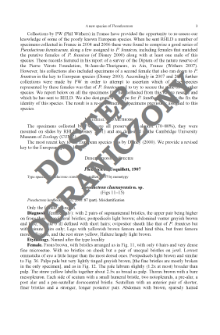
Object
Title: A review of the New World species of the shore-fly genus Leptopsilopa Cresson (Diptera: Ephydridae)
Subtitle:
Annales Zoologici, vol. 56, no 1 ; Shore-fly genus Leptopsilopa Cresson (Diptera: Ephydridae)
Contributor:
Muzeum i Instytut Zoologii Polskiej Akademii Nauk
Publisher:
Place of publishing:
Description:
Bibliogr. p. 137-138 ; P. 85-138 : ill. ; 27 cm ; Taxa in Latin
Type of object:
Abstract:
The 12 New World species of Leptopsilopa are reviewed, including the following new species (type localities noted parenthetically): L. andiana (Peru. Huánuco: Espensa, [11 km N Huánuco]), L. flavicoxa (Belize. Stann Creek: Cockscomb Basin Wildlife Sanctuary [16°47'N, 88°30'W]), L. martharum (United States. Texas. Jim Wells: Mathis(7.5 km S; Nueces River; 28°02.2'N, 97°52.2'W; 15 m), and L. placentia (Belize. Stann Creek:Placentia Lagoon, Rum Point; 16°32'N, 88°21'W). Lectotypes are designated for Psilopasimilis Coquillett, Psilopa varipes Coquillett, and Psilopa metallina Becker. The monophyly of Leptopsilopa is established, but only if the Old World species are excluded. The genus is most closely related to a lineage of species currently included in the genus Psilopa (thedupla group, including P. metallina), which is rendered paraphyletic by the recognition of Leptopsilopa as an included, monophyletic lineage. The New World species are arranged into two monophyletic species groups, the atrimana and the similis groups. Of the 12 species now recognized, 10 occur in the neotropics, where other undescribed species will probably be discovered.
Relation:
Volume:
Issue:
Start page:
End page:
Detailed Resource Type:
Format:
Resource Identifier:
Source:
MiIZ PAN, call no. P.255, vol 56, no 1 ; MiIZ PAN, call no. P.4314, vol 56, no 1 ; click here to follow the link
Language:
Language of abstract:
Rights:
Rights Reserved - Restricted Access
Terms of use:
Digitizing institution:
Museum and Institute of Zoology of the Polish Academy of Sciences
Original in:
Library of the Museum and Institute of Zoology of the Polish Academy of Sciences
Projects co-financed by:
European Union. European Regional Development Fund ; Programme Innovative Economy, 2010-2014, Priority Axis 2. R&D infrastructure
Access:
Object collections:
- Digital Repository of Scientific Institutes > Partners' collections > Museum and Institute of Zoology PAS > Scientific Journals
- Digital Repository of Scientific Institutes > Partners' collections > Museum and Institute of Zoology PAS > MIZ PAN Publications > Annales Zoologici
- Digital Repository of Scientific Institutes > Literature > Journals/Articles
Last modified:
Oct 2, 2020
In our library since:
Feb 3, 2015
Number of object content downloads / hits:
398
All available object's versions:
https://rcin.org.pl/publication/54769
Show description in RDF format:
Show description in RDFa format:
Show description in OAI-PMH format:
| Edition name | Date |
|---|---|
| Review of the New World species of the shore-fly genus Leptopsilopa Cresson (Diptera: Ephydridae) / Mathis, Wayne N. | Oct 2, 2020 |
Objects Similar
Mathis, Wayne N. Zatwarnicki, Tadeusz
Mathis, Wayne N. Zatwarnicki, Tadeusz
Zatwarnicki, Tadeusz Mathis, Wayne N.
Zatwarnicki, Tadeusz
Mączak, Antoni (1928–2003)
Skórczewski, Dariusz
Koberdowa, Irena (1916–2008)

 INSTYTUT ARCHEOLOGII I ETNOLOGII POLSKIEJ AKADEMII NAUK
INSTYTUT ARCHEOLOGII I ETNOLOGII POLSKIEJ AKADEMII NAUK
 INSTYTUT BADAŃ LITERACKICH POLSKIEJ AKADEMII NAUK
INSTYTUT BADAŃ LITERACKICH POLSKIEJ AKADEMII NAUK
 INSTYTUT BADAWCZY LEŚNICTWA
INSTYTUT BADAWCZY LEŚNICTWA
 INSTYTUT BIOLOGII DOŚWIADCZALNEJ IM. MARCELEGO NENCKIEGO POLSKIEJ AKADEMII NAUK
INSTYTUT BIOLOGII DOŚWIADCZALNEJ IM. MARCELEGO NENCKIEGO POLSKIEJ AKADEMII NAUK
 INSTYTUT BIOLOGII SSAKÓW POLSKIEJ AKADEMII NAUK
INSTYTUT BIOLOGII SSAKÓW POLSKIEJ AKADEMII NAUK
 INSTYTUT CHEMII FIZYCZNEJ PAN
INSTYTUT CHEMII FIZYCZNEJ PAN
 INSTYTUT CHEMII ORGANICZNEJ PAN
INSTYTUT CHEMII ORGANICZNEJ PAN
 INSTYTUT FILOZOFII I SOCJOLOGII PAN
INSTYTUT FILOZOFII I SOCJOLOGII PAN
 INSTYTUT GEOGRAFII I PRZESTRZENNEGO ZAGOSPODAROWANIA PAN
INSTYTUT GEOGRAFII I PRZESTRZENNEGO ZAGOSPODAROWANIA PAN
 INSTYTUT HISTORII im. TADEUSZA MANTEUFFLA POLSKIEJ AKADEMII NAUK
INSTYTUT HISTORII im. TADEUSZA MANTEUFFLA POLSKIEJ AKADEMII NAUK
 INSTYTUT JĘZYKA POLSKIEGO POLSKIEJ AKADEMII NAUK
INSTYTUT JĘZYKA POLSKIEGO POLSKIEJ AKADEMII NAUK
 INSTYTUT MATEMATYCZNY PAN
INSTYTUT MATEMATYCZNY PAN
 INSTYTUT MEDYCYNY DOŚWIADCZALNEJ I KLINICZNEJ IM.MIROSŁAWA MOSSAKOWSKIEGO POLSKIEJ AKADEMII NAUK
INSTYTUT MEDYCYNY DOŚWIADCZALNEJ I KLINICZNEJ IM.MIROSŁAWA MOSSAKOWSKIEGO POLSKIEJ AKADEMII NAUK
 INSTYTUT PODSTAWOWYCH PROBLEMÓW TECHNIKI PAN
INSTYTUT PODSTAWOWYCH PROBLEMÓW TECHNIKI PAN
 INSTYTUT SLAWISTYKI PAN
INSTYTUT SLAWISTYKI PAN
 SIEĆ BADAWCZA ŁUKASIEWICZ - INSTYTUT TECHNOLOGII MATERIAŁÓW ELEKTRONICZNYCH
SIEĆ BADAWCZA ŁUKASIEWICZ - INSTYTUT TECHNOLOGII MATERIAŁÓW ELEKTRONICZNYCH
 MUZEUM I INSTYTUT ZOOLOGII POLSKIEJ AKADEMII NAUK
MUZEUM I INSTYTUT ZOOLOGII POLSKIEJ AKADEMII NAUK
 INSTYTUT BADAŃ SYSTEMOWYCH PAN
INSTYTUT BADAŃ SYSTEMOWYCH PAN
 INSTYTUT BOTANIKI IM. WŁADYSŁAWA SZAFERA POLSKIEJ AKADEMII NAUK
INSTYTUT BOTANIKI IM. WŁADYSŁAWA SZAFERA POLSKIEJ AKADEMII NAUK


































